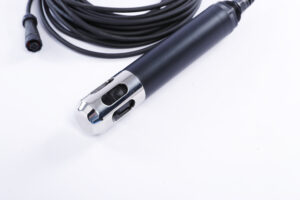DO sensors can be designed based on different technological principles, with one of them being the fluorescence method. Fluorescence-based dissolved oxygen sensors utilize a specific material’s response to active fluorescence extinction, a principle from physics. Typically, the sensor’s front end consists of two light-emitting diodes (LEDs), one emitting blue light and the other emitting red light, along with a photodetector and a fluorescence cap.
The blue LED emits modulated blue light, which irradiates the fluorescent material on the inner surface of the cap, causing it to emit red fluorescence upon excitation. The photodetector detects the red fluorescence and compares it with a reference light. By calculating the phase difference between the two and comparing it with internal calibration values, the concentration of oxygen molecules can be determined. Additionally, the sensor automatically compensates for temperature and pressure to output the final dissolved oxygen concentration value.
This fluorescence-based DO sensor has a simple structure and leverages the properties of fluorescent materials to achieve precise dissolved oxygen concentration measurements, providing reliable data in various environmental conditions.
Send Inquiry





















